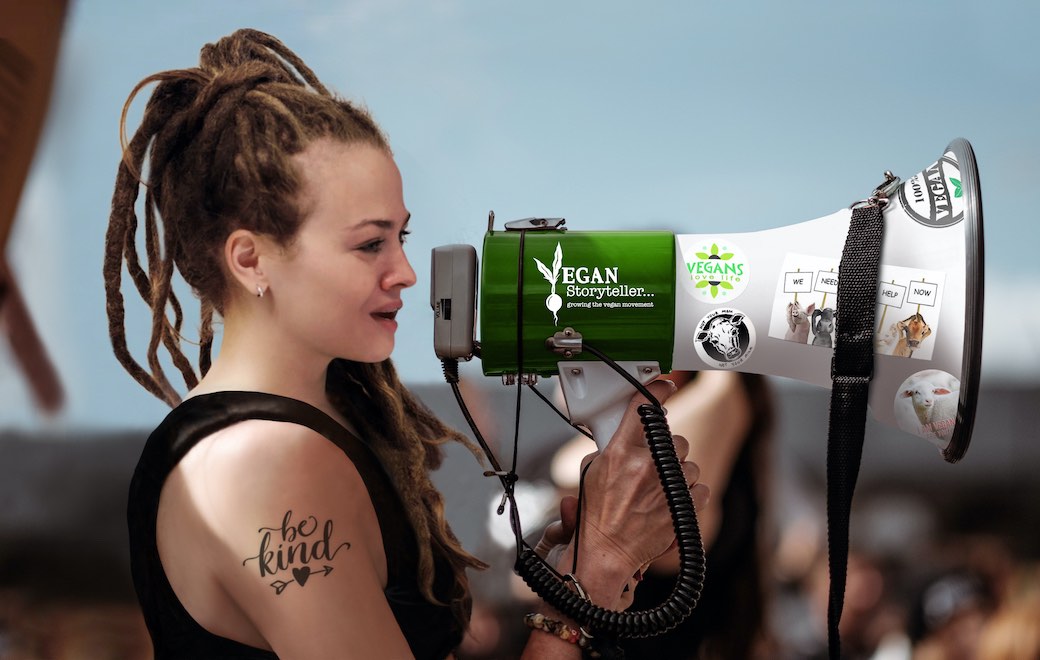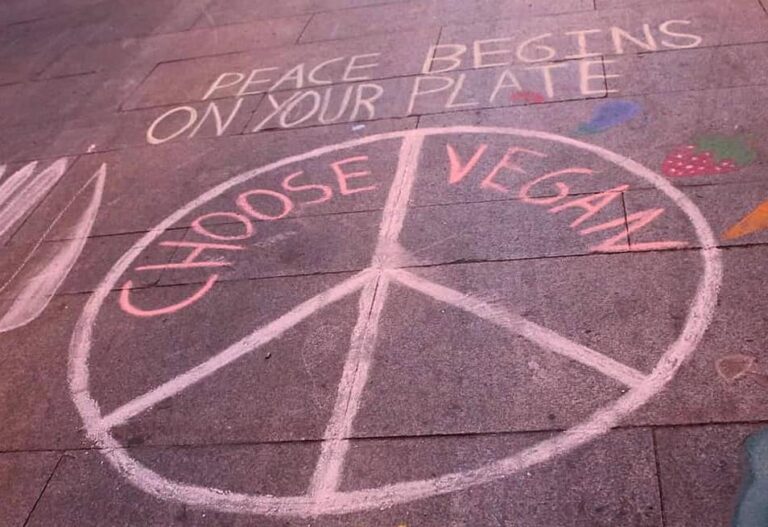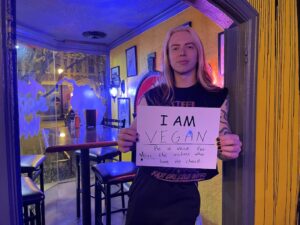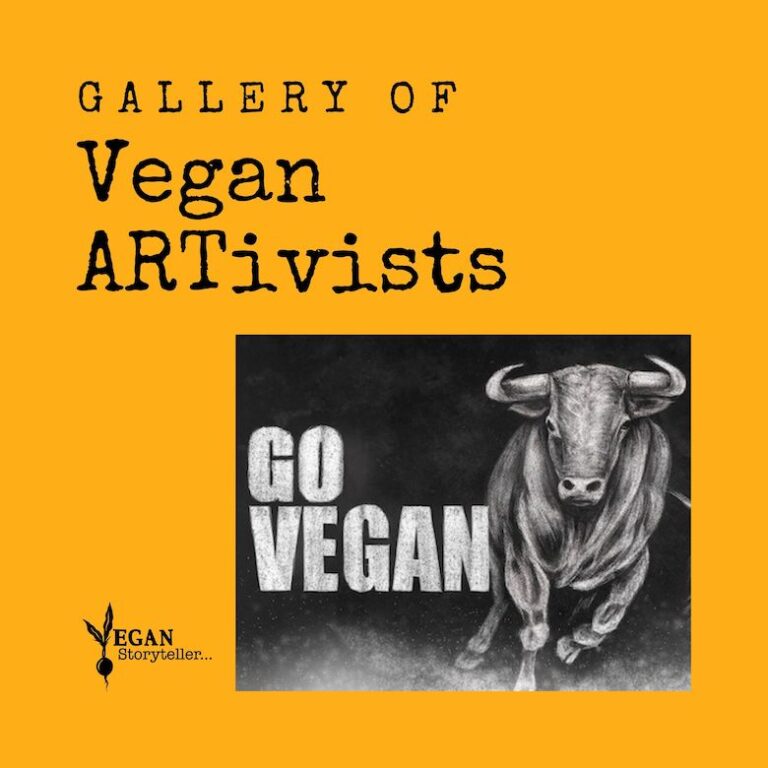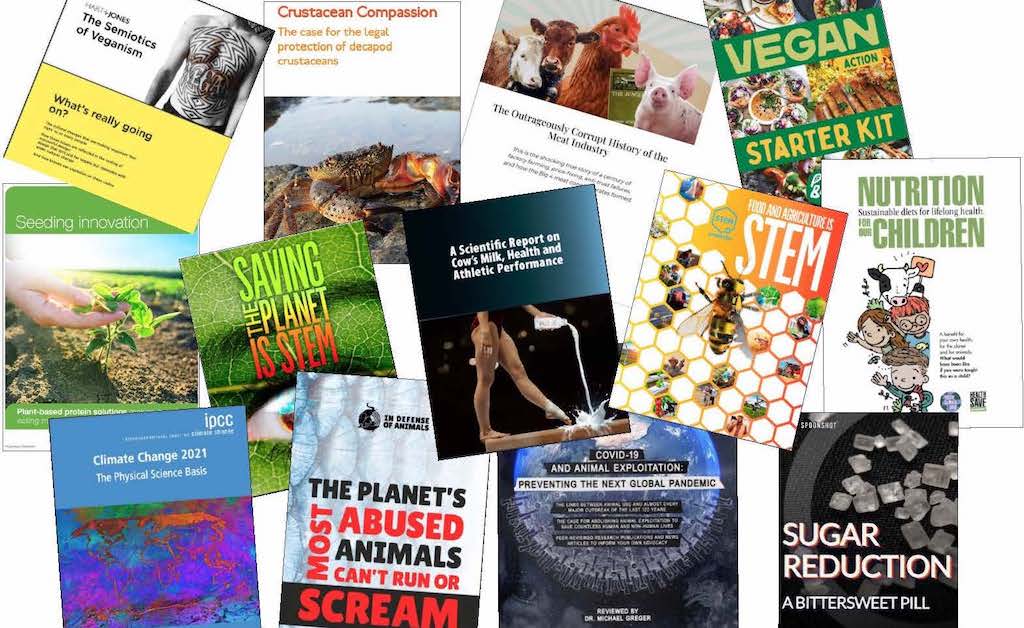Vegan advocacy actions are an important part of growing the vegan movement. Most of us take direct action to further the vegan cause because we have a set of values that excite us:
- Compassion for animals
- Care for the environment
- Concern for personal health
- Calling toward a religious or spiritual belief
During my 40+ years advocating for veganism, environmentalism, feminism, and social justice, I have learned that the deep desire to make an impact is what draws most people to activism and brings us together on common ground.
Vegans enter the world of advocacy the moment we transition to a plant-based diet. Choosing to go vegan automatically creates positive social change. We save animals and the planet and improve our health and spiritual well-being by not eating meat and dairy.
Most of us choose particular vegan advocacy actions by matching actions with our personalities. We consider what inspires and motivates us in order to make the best use of our time and energy.
For example, large noisy crowds that grab media attention energize some of us. Others are more comfortable working behind-the-scenes to research and blog about vegan concerns or create art to promote veganism.
It’s important to be authentic in our advocacy actions so that our passion comes through and so that we don’t burn out too quickly from displaced energy.
Encouraging people to become vegan through vegan advocacy actions
Pascale Salmon, Vegan Storyteller Gallery of Vegan ARTivists.
Many ethical vegans become activists to teach empathy. It’s no wonder, seeing how the global meat industry kills 77 billion animals every year. Add to this death toll the countless wild animals that are murdered because they are seen as threats to cattle and elk.
Our obligation as vegans is to encourage humanity over killing in our messaging. We need to open people’s eyes and cause them to think about their attitudes and behavior. Vegan advocacy actions are one way to do this.
We also need to make it easy for people to transition to veganism. Our messaging and direct actions need to support this goal. For example, we can easily help others become vegan by directing them to websites where they can take a pledge or accept a challenge to go vegan. Click here to learn about vegan pledges and challenges that are in place to help beginner vegans.
Other ways we can entice people to consider veganism is by holding vegan bake sales, operating vegan food trucks, and organizing vegan dinner parties where people can try plant-based foods.
Holding vegan culinary competitions and tea parties for kids and giving out vegan food samples on college campuses are other ways to help people become vegan. Sharing vegan recipes and producing vegan cooking shows and podcasts are also effective in helping non-vegans transition from meat and dairy to plant-based eating
Use creative vegan messages to reach the masses
Our messages and actions need to look and feel a thousand different ways to reach the masses. Activist messaging can carry the voice of a rebel, hero, avenger, game-changing athlete or any other archetype. The messaging point of view can come from foodies and herbalists, spiritual yogis, filmmakers, teachers, and other wise sages. They can come from poets, writers, musicians, and artists. Vegan thought leaders and influencers can point the way, as can each one of us as every day people.
We can get attention by carrying messages on campaign posters and in leaflets we distribute. We can inspire others to join the vegan movement and animal rights movement by telling hopeful stories of sanctuaries for farm animals and by telling heroic stories of vegan activists who liberate animals from fur farms and science labs.
And we can educate people through the speeches, signs, and websites we make as part of our vegan advocacy actions. In other words, we can use our voices in endless ways to save animals, the planet, and our health. The more creative we are in our messaging, the more people we will reach with our messages
Vegan butchers respond to environmental impacts and animal welfare

For many years, vegan messaging was directed to progressive communities along the coasts. But veganism is finally trending in the Midwest.
As a result of increased vegan advocacy actions and demand for vegan foods, eateries and food producers can no longer ignore vegans in the heartland.
Every activist knows the old adage holds true — “If you want something done right, do it yourself.”
Doing it themselves is what the brother-sister vegan duo Aubry and Kale Walch did when they opened The Herbivorous Butcher in Minneapolis, Minnesota, in 2016. The business grew from a pop-up stand at the Minneapolis Farmers Market to the nation’s first vegan butcher shop. With a flourish of energy and enthusiasm, the Walch’s meat-free meats and cheese-free cheeses have gained popularity.
Their starter kit includes vegan ribeye steak, pastrami, Korean BBQ ribs, pepperoni, Italian sausage, bacon brats, maple sage breakfast sausage, and garlic pepper Havarti cheese.
The brother-sister team states on The Herbivorous Butcher website, “The need for meat alternatives has never been greater. Global demand for meat has tripled in the last 40 years, causing dramatic and unsustainable increases in greenhouse gas emissions, deforestation, and water pollution, intensifying pressures on land, water, fertilizer, feed, and fuel.
“A modest reduction in the consumption of animal products would not only spare billions of animals from inhumane treatment every year, but would have a huge environmental impact at a time when the world urgently needs to reduce greenhouse gas emissions to avert catastrophic climate change. We are responding to this call to action because together we can all change the world one meal at a time!”
There are other vegan butcher shops opening in the Midwest as pop-ups and bricks and mortar, including Vida’s Plant-Based Butcher in Columbus, Ohio. An important element of our vegan advocacy actions is to support these businesses by buying their products.
Our duty as ethical vegan activists
It is the moral duty of vegan activists to support plant-based businesses by buying their vegan products, eating in their restaurants, and spreading the word about their establishments. Who will help vegan businesses thrive if vegans don’t?
We shouldn’t rest until the number of vegan burger joints surpasses the number of animal-based burger joints. As vegan consumers, we can’t expect to get what we want — and the animals deserve — if we don’t take action.
Vegan activism makes people aware of the painful stories behind the food industry, fashion industry, and science research industry. It’s up to us to tell the stories. According to data collected in public and private polls and surveys, most people care about animals and do not want to harm them. Being exposed to vegan messaging awakens people to their own core values and helps them make better choices.
Scaling vegan advocacy actions and efforts to change the world
There is a global environmental tree planting campaign called A Trillion Trees. Environmental activists have joined forces to protect and restore forests by planting one trillion trees by 2050, for the benefit of people, nature, and a stable climate.
What if vegan activists began A Trillion Animals campaign to end the cruelty of animals?
It’s not a far-fetched fantasy, especially when we consider a man who saved millions of animals on his own. He did this in the early 1970s, decades before the advent of social media and cell phones. If he could save millions of animals without the aid of technology, imagine what we would be capable of achieving if we did what he did using the internet and all of the digital tools at our disposal today.
Here’s how the story goes of one man’s vegan advocacy actions:
How a man who had compassion for animals saved millions of them from torture and death
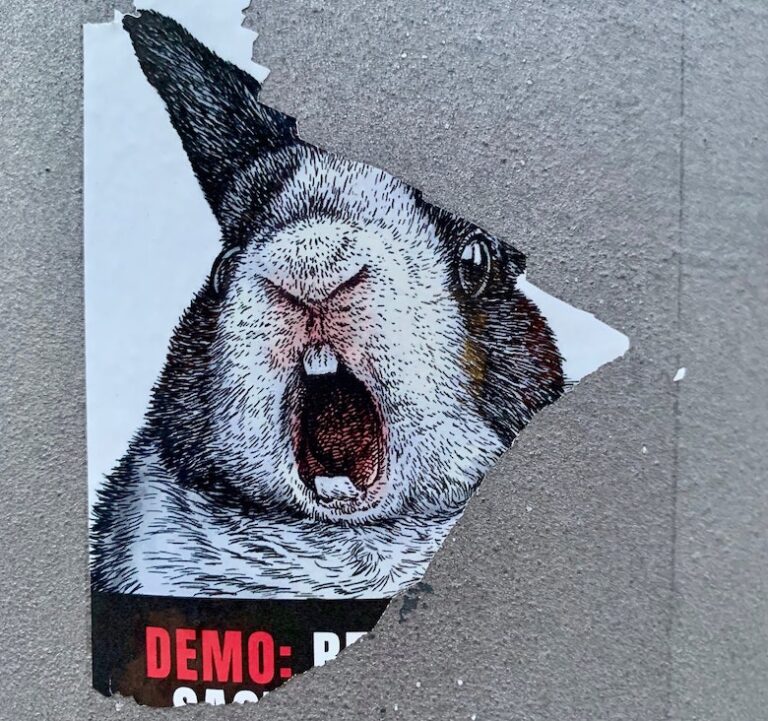
bekky bekks, Unsplash
When the modern animal rights movement began in the early 1970s, a man named Henry Spira obsessed over finding ways to “add a zero or two” to the number of animals he wanted to protect.
He found ways to scale up his efforts to protect as many animals as possible. This mindset permeated all of Henry’s activist campaigns. In Peter Singer’s biography of Henry, Ethics Into Action, Spira recounts the campaigns he led to spare tens of millions of animals from suffering.
Henry Spira was the first large-scale animal rights activist and is regarded by some as one of the most effective animal advocates of the 20th century. In 1974, he founded Animal Rights International (ARI) to put pressure on companies that tested on animals.
Two years later he led the ARI’s campaign against vivisection on cats that the American Museum of Natural History had been conducting for 20 years for sex research. The museum halted its research in 1977. Henry’s campaign, a bold act of vegan advocacy, was hailed as the first ever to succeed in stopping animal experiments.
Another well-known campaign targeted cosmetics giant Revlon’s use of dripping substances into animals’ eyes, usually rabbits, to determine whether they are toxic. On April 15, 1980, Henry and the ARI took out a full-page ad in the New York Times, with the headline, How many rabbits does Revlon blind for beauty’s sake?
Within a year, Revlon had donated $750,000 to a fund to investigate alternatives to animal testing, followed by substantial donations from Avon, Bristol Meyers, Estée Lauder, Max Factor, Chanel, and Mary Kay Cosmetics. The donations led to the creation of the Center for Alternatives to Animal Testing at John Hopkins University.
Henry Spira told The New York Times that he first became interested in animal rights in 1973 while looking after a friend’s cat.
He told the reporter, ”I began to wonder about the appropriateness of cuddling one animal while sticking a knife and fork into another.”
Today, Cruelty Free International is one of the leading organizations working to end animal experiments worldwide.
Keep vegan advocacy actions focused and in perspective
When it comes to activism, there are two critical points to keep in mind:
- Stay focused. Keep your message clear like Henry Spira did in his campaigns to end animal testing.
- Keep things in perspective.
We can be tempted to compare ourselves to highly successful organizations and influential activists and feel we are not doing enough. Don’t travel that path.
Many of today’s success stories of vegan activism had humble beginnings. Two of the largest vegan festivals — VegFest and Veganuary — are outgrowths of small monthly potlucks and meetups.
Think of Peter Singer if you ever feel that you are not doing enough. His book Animal Liberation is one of the bestselling books in the animal rights movement. Initially, that book was a single essay. Only after his essay gained considerable attention did Singer expand it into the best-selling book.
Never doubt that a small group of thoughtful, committed citizens can change the world. Indeed, it is the only thing that ever has.
Margaret Meade Tweet
The late anthropologist Margaret Meade believed in the power of the individual to make a difference. She said, “Never doubt that a small group of thoughtful, committed citizens can change the world. Indeed, it is the only thing that ever has.”
Read next How to get your vegan advocacy actions funded through foundations and angel investors.
The types of vegan advocacy actions
Most forms of activism fall into about a dozen broad categories. But the sky’s the limit when shaping vegan advocacy within a particular category. Take a look and see how you can best connect with these actions.
1. Direct actions
Direct actions are at the heart of vegan activism. These include protest marches and rallies, as well as strikes, street theater, sit-ins, sleep-ins, teach-ins, and virtual sit-ins that cause the computers of unethical corporations to crash.
Direct action campaigns are often disruptive and uncivil. They are meant to throw people off balance and make them think about the pain and suffering of animals and the destruction of the environment.
These types of actions are not for the timid. Participating in hard-core actions can lead to arrest. But activists know the rewards of their deeds far outweigh the risks. In fact, I know first-hand from having worked at Veterans for Peace, that many activists treat their arrest records as badges of honor.
Additionally, I work for an order of Catholic nuns who believe it is God’s will to stand up against social wrongs. They protest social injustices and are not afraid of being arrested for civil acts of disobedience.
Nonetheless, it might be a good idea to research the laws in the area where you will be performing a direct action in case you get arrested. Based on my personal experiences, you will pay a fine and get released from jail within 3-6 hours of being arrested.
However, jail sentences can get scary, so it helps to be aware of what could possibly happen to you if you are arrested.
2. Boycotts

Adbusters
Veganism and boycotting go hand-in-hand as vegan advocacy actions. This is inevitable since being vegan automatically implies opposing the status quo.
Vegans opt out of practices that harm animals, nature, and the body. We choose life over killing. So, we ensure the products we buy, including food, clothing, personal care, and household items are both animal and environmentally friendly. By making consumer choices that nourish our bodies, the planet, and the well-being of animals, we uphold the value of love. We boycott businesses and products that don’t share these ideals.
Boycotting is a powerful activist tactic. Having this kind of power allows us to choose each day how we will spend our money. We refuse to purchase products from unethical companies, and we refuse to travel to states engaged in unethical activities such as Idaho’s mass genocide of wolves.
When organized on a large scale, boycotts generate thousands of complaints to companies and governors that can force policy changes. By using a boycott action, we can invite many groups to join our cause, including those that are not vegan. There is strength in numbers. It makes sense to call a conference with representatives from many groups in order to develop a collective plan of action.
3. Lobbying elected leaders
I learned how to lobby directly on Capitol Hill in Washington, DC, during Ecumenical Advocacy Days. The lobbying process brought me into direct contact with elected government officials.
The way it works is simple. The democratic process is a walk-in process. You can enter the office of an elected representative of your congressional district with or without an appointment and request meetings. When lobbying my elected leaders in Washington, DC, I have had as many as four meetings in one day.
There have been instances where I have actually met with the elected officials. But more frequently, I have found myself lobbying legislative aides. The aides are the ones who formulate policies and draft documents for the elected leaders to sign. Therefore, meeting with legislative aides is not a waste of time.
You inform an aide or elected official of your concern at the meeting. State how many people you represent and in what territory so that it is clear you are not acting alone. Describe specifically what support you want from the leader or aide.
Be sure to leave materials behind that summarize your position, and provide contact information for getting in touch with you.
Lobbying is most successful when activists enter a meeting with one targeted “ask” rather than a long list of demands. Alternatively, if traveling isn’t an option for you or if you don’t enjoy face-to-face meetings, you can call your representatives.
4. Volunteering at the grassroots level
When we engage in advocacy, many of us start at the grassroots level because it’s easy to find opportunities and instantly connect with like-minded people. Additionally, grassroots activism tends to focus on a single issue that most members of the community can either relate to or care about.
In general, grassroots activism seeks to garner local publicity to express discontent and demand change. When activists speak with one voice to represent a community, it’s hard for the media to ignore the story.
Over the years, I’ve been involved in activism on the local, state, and national levels. It is local actions that I have always preferred for the rapid change they can bring. In addition, there is something inherently satisfying about being directly involved in a campaign that improves the quality of life for people and animals where I live.
For big problems like industrial farming and climate change, grassroots movements can help scale collective actions quickly. A conference call with grassroots leaders can mobilize supporters for campaigns and actions on a regional or national scale.
Through this process of vegan advocacy, the movement swells and becomes big enough to shift the status quo to affect permanent social change.
5. Writing letters

Anthony Shkraba, Pexels
A tried and true form of activism is writing letters to government leaders, including the President of the United States. Politicians know their reelection depends directly on constituents, so they pay close attention to what people write to them about. Don’t bother with Email campaigns; they are viewed as spam.
In the course of my own letter-writing campaigns, I have found the most effective and enjoyable methods involve gathering activists together and writing letters about one issue, usually over drinks, food, and small talk. Here are a few tips to help you have a successful letter writing campaign as part of your arsenal of vegan advocacy actions:
- Be sure to identity the legislation in the letter so the elected official knows what you are talking about. Also include supporting information and your personal experience with the issue. The most effective and persuasive lobbying tool is anecdotal evidence.
- Don’t use jargon or acronyms. Use simple and direct language. Make sure you ask the recipient for something specific in the letter. For example, if you want legislators to support a specific bill, then ask them to do so. If you want them to introduce a bill, then tell them what you want them to introduce.
- Thank the people you are writing to for their time, effort, or support of whatever it is you are asking of them.
- Finally, don’t forget to include your name and address so legislators can contact you.
6. Getting petitions signed
Petitions show support for a cause and give an issue clout. They serve as a signal of public opinion to decision makers. They play an important role in strengthening the vegan movement and animal rights movement.
Petitions are excellent forms of vegan advocacy actions because media outlets evaluate them in order to determine if there is enough public sentiment to justify writing a story about the issue. Petitions also build a list of people who care about the issue, which you can then use to raise money and inspire further action.
Make sure petitions are well-thought out. You need to target a specific person, government agency or company. The petition must have a clearly stated action you want the recipient to take.
A well-timed, well-crafted petition can draw public attention to an issue and get people involved in other actions related to that issue. If enough people pull together in targeted petition actions, change can occur.
We saw evidence of this advocacy action immediately following the murder of Cecil the lion by an American dentist in Zimbabwe. The online group SumOfUs.org responded with outrage to the killing. Leaders of the group created a petition to pressure airlines to change their policies and stop transporting endangered animals.
The group targeted Delta Airlines when it was slow to act. Following Delta’s announcement that it would comply, American, United, and Virgin Atlantic quickly followed.
Every petition needs a short, attention-grabbing title. Tell people in one or two sentences why they should sign your petition. Tell them why the issue is important to you or why you represent the cause so they can connect with you emotionally.
7. Disrupting the status quo

Adbusters
And then there are the exciting vegan advocacy actions known as disruptive campaigns that force people to think in a whole new way. This type of activism can be radical. PETA has mastered the art of disruptive campaigns through its shock-inducing anti-fur, anti-circus, and anti-vivisection campaigns.
Adbusters is another disruption leader. Using radical design and media strategies, the collective of poets, punks, and philosophers aims to shake up complacent consumer culture around the world.
On May 1, 2021, Adbusters blared from its online platform, “Alright you radicals, rebels and redeemers out there … Once in every era, the call of history compels a small number of people — or even just one person — to steer the world in a fresh new direction. This is that call. Why? The Earth is on fire. An unjust and destructive financial system threatens to pull everything down with it as it crumbles under its own weight.”
The Adbusters announcement is in preparation for its Worldwide General Strike on September 17th – Occupy Wall Street’s 10th anniversary.
History-making ideas always seem crazy at first. Think of the Wright brothers at Kitty Hawk (flight), Tesla and Edison (electricity), Alexander Graham Bell (telephone), and Johannes Gutenberg (printing press).
“It just takes someone bold enough to act on them — and then change the world,” the disrupters at Adbusters declare.
8. Donating money and buying wisely
Giving money to causes is another form of direct action. Donations help animal rights and environmental organizations carry out their missions, ensuring that animals and the planet are treated justly.
Likewise, buying wisely allows cruelty-free companies to carve out a niche in a market traditionally dominated by businesses that abuse animals and the environment. By spending our money in an ethical manner, we can make the world a better place.
When we become philanthropists and wise consumers, we also gain something in return. We feel happiness. We feel like our lives have greater purpose. And when we use our money for good, we set an example for others to follow.
Whether we give a lot or a little, what matters most is the intention behind the money. By setting intentions, we can align our actions with our values and stay focused on our top priorities in life. Setting intentions also helps us to be conscious of what we want to accomplish with our money.
Like all vegan activism, donating money and buying wisely come with responsibilities. Our first step should be to vet charitable organizations to ensure they are legitimate and conform to our vegan ideals. There are systems in place to assist with this task, including Guidestar, Charity Navigator, and the BBB Wise Giving Alliance.
Our next step would be to research companies to ensure that they are cruelty-free. For example, before I purchase consumer products I am not familiar with, I check the PETA (People for the Ethical Treatment of Animals) website.
The PETA consumer guides are an invaluable resource when purchasing vegan clothing, cosmetics, household products, and more.
Crowdfunding campaigns
You can also support crowdfunding campaigns as a way to manifest something good with small amounts of money. Crowdfunding campaigns tend to target niche communities. This means that you will sometimes find strong forces of good organized on crowdfunding sites for veganism, animal liberation, and environmentalism. But be sure to do your due diligence to avoid being duped by fraudulent campaigns.
How to help if you don't have money
There are other ways to help the vegan cause if you don’t have cash to spare. Internet searches can provide the information you need for your own region.
- Use charity search engines such as iGive and Goodshop.
- Purchase items from charity organizations.
- Shop through fundraising sites like smile.amazon.
- Play online games that donate to charity.
- Make crafts for charity. Some of the nuns I work for crochet baby blankets for an unwed mother program.
- Donate your old vehicle.
- Hold a yard sale and donate the money you make to charity.
- Ask friends on Facebook to support your cause.
- Collect recycled items, sell them, and give the money to charity.
- Get creative and think of all the ways you can donate money to animal welfare and environmental charities.
9. Using your talent as an ARTivist
Art is one of the most imaginative ways to promote a vegan lifestyle. The idea of ARTivism was born out of a 1997 meeting between East Los Angeles Chicano artists and the Zapatistas in Chiapas, Mexico. A variety of art and music events and actions followed on the heels of the meeting and helped popularize the term.
ARTivism’s most famous artist, Bansky, predates the term. Bansky began as a freehand graffiti artist in 1990 in Bristol, England. By 2000 he had switched to stencils after he realized how much faster he could finish a work using them. With stenciling, he was able to create ingenious anti-establishment messages on public walls without the usual time pressure. With ready made templates, he could spray paint a wall in seconds without being seen. He brought advocacy to the streets in a fresh way.
The only materials necessary for making stencils are cardboard or plastic (any size), spray paint (any color), and X-acto knives and scissors. If you’re looking for free printable stencils, including Bansky stencils, visit FreeStencilGallery.com. It’s the top website for free printable stencils and includes tutorials.
As a side note, Bansky’s hometown Bristol is the vegan capital of the world. So, is Bansky vegan? No one knows his identity to ask him.
ARTivism blends direct street action with dramatic creative works to fight against injustice and oppression. It is rooted in activism and art, hence the combination of words.
Vegan Storyteller features vegan ARTivists who use their imagination and artistic talent to raise awareness about veganism, animal rights, and the environment.
Using stickers
Let’s not forget stickers as a way to fight for justice and promote veganism. Stickers get the point across and can be applied quickly. They stick to most surfaces. You can purchase stickers online or make your own. They don’t cost much if you decide to buy them.
Using spray paint
In the words of Hilary Greenbaum and Dana Rubinstein for The New York Times when reporting on the history of spray paint:
“While it is impossible to determine the first student or activist to aim an aerosol paint can at cardboard or buildings, forefathers of the latter include Cornbread and Julio 204, the Philadelphia – and New York-based artist-defacers, who took advantage of the technology to make their tags (né names) well known in the ’60s and ’70s.
“Spray paint, after all, was the ideal medium for this form of branding. It came in small, easy-to-conceal, easy-to-steal cans. It was paint and brush in one. It dried quickly. It worked well on building materials and subway cars.
“More important, perhaps, the imprecise application lent it an inherent disregard. Its inability to be perfectly controlled also made it an apt metaphor for rebellion. In other words, it was pretty badass.”
As a cautionary note, be aware that some laws and ordinances consider applying spray paint, stencils, and stickers to be acts of vandalism. Not everyone appreciates ARTivism or other forms of vegan advocacy. Graffiti artist “Super” is serving a 10-year prison sentence for spray painting walls and buildings across St. Louis.
Street art is still considered vandalism in many places. In other places, graffiti is highly prized by art collectors. Hedge fund investors have been known to chisel out bits of walls to own a chunk of an original Banksy.
The business investment in upfront costs for ARTivists is minimal. Here’s the basic arsenal that street artists carry with them into unauthorized public spaces.
- Thick cardboard or plastic sheets
- Stencils
- X-acto knives
- Spray paint
- Extra nozzles for spray paint
- Paint markers or fat, permanent markers
10. Tackling social media activism
#hashtag activism

Think about #MeToo for a second and you will have captured the essence of hashtag activism.
Activist Tarana Burke was 33 years old when she started the #MeToo hashtag in 2006. This simple hashtag was posted more than 19 million times in a single year.
The hashtag became a social movement and led to the establishment of a legal defense fund that raised $24 million and connected 3,677 people to attorneys to pursue legal action for sexual harassment allegations. Now, that’s activism!
Among the top hashtags trending for vegan are #vegan, #veganiseasy, #plantbasedrecipes, and #veganlife. There is the potential for any of these to become the next #MeToo if enough vegan activists step up to make it happen through action.
Vegan posting strategies on social media
The concept of social capital is crucial to activists, so let’s define it. Social capital represents the trust and goodwill you’ve earned from people. It varies from person to person.
The people who are kind and generous and who have lots of friends have more social capital than hostile people who isolate themselves.
People are more likely to listen to you if you have social capital. You will also be more likely to get them to sign a petition, donate to a cause, or act favorably on other requests you make.
Don’t waste your social capital by repeatedly posting graphic images of animal cruelty. The images make people feel helpless and hopeless. To inspire others, share snippets of your life and the causes you care about in a positive light.
Keep your social capital strong to ensure that your carefully selected vegan and animal rights messages and calls to action are viewed positively.
Here’s the latest school of thought on how and when to post vegan messages on social media:
- You can post several links about veganism each day on Twitter, Instagram, and Snapchat.
- However, on Facebook, limit vegan posts to once a week or less. In between vegan posts, you should highlight other aspects of your life. If your Facebook friends regularly see you posting personal posts that interest them, they are much more likely to engage with your vegan posts.
11. Watching movies as an act of vegan activism

Samson Katt, Pexels
Vegan activism doesn’t have to be exhausting. Watching vegan documentaries and writing short critiques about them on my Facebook page is one way I enjoy advocating for veganism.
Other vegans I know enjoy screening documentaries and arranging community movie nights to discuss veganism and related issues. It’s a worthwhile pursuit because non-vegans can discover the vegan lifestyle through movies. Many people have turned vegan after watching a film about animal liberation, the environment, or vegan health.
A quick internet search for vegan movies or vegan documentaries will call up a list of epic titles including:
- Cowspiracy: The Sustainability Secret
- The Game Changers
- Dominion
- Earthlings
- Forks Over Knives
- What the Health
- Meet Your Meat
Gunda, one of the newest vegan documentaries in 2021, explores the concept of pig sentience. Vegan activist and actor Joaquin Phoenix is the film’s executive producer. The new release from vegan activist Joey Carbstrong, Milk: Make Your Own Mind Up, exposes what the dairy industry does’t want us to know. Another 2021 release, Seaspiracy, uncovers the commercial fishing industry’s harmful practices. The film comes from producer Kip Andersen, who was also behind Cowspiracy and What the Health.
A growing interest in animal rights documentaries reflects the growing popularity of plant-based meat alternatives. A platform that curates films with strong vegan and animal-rights themes, VegMovies, made its debut in 2020 to help users find and share vegan-themed movies and support those that are in development.
Documentaries that challenge our thinking can trigger emotions such as empathy and compassion. They can also boost our emotional intelligence. A great way to engage in vegan activism is by attending film screenings with friends or hosting watch parties.
12. Blogging activism
In my own life, my commitment to a plant-based lifestyle is as strong today as it was 40 years ago when I stopped seeing animals as sources of food, beverages, and clothing.
However, as I get older, I am less able to travel long distances for marches and sit-ins in Washington, DC. Thus, my blog Vegan Storyteller has become my primary form of activism.
I use blogging activism to conduct interviews with vegan thinkers and share stories about vegan activists as a way to inspire and motivate others to grow the vegan movement. I also like being able to provide information that is useful to vegan activists to help strengthen their vegan advocacy actions.
We can all use blogging as a tool for vegan advocacy. There are many websites that explain blogging in detail, so I won’t go into that here. But I will say that in general, you need these five things to start blogging:
- Register a domain name
- Buy website hosting
- Find a niche
- Choose a theme for your blog
- Design your blog and start writing
Food choice is an act of resistance

Nataliya Vaitkevich, Pexels
When we eat vegan, we impact the environment in ways that are far greater than those of any other method of becoming eco-friendly. By cutting out foods that contribute to climate change, we stop funding industries that are killing the planet. We dismantle animal cruelty.
We become more aware of our food choices as we learn how harmful industrial farming is and champion whole foods. Eating plants is an act of resistance. Through our diet, we strive to change the damaging practices of corporations. We educate people about the environmental impact of their food choices and use food to counter injustices both as individual acts and as an organized social movement for animal rights.
Restaurant activism
Food joins the ranks of activism when we advocate for vegan restaurants. The number of vegan eateries is steadily rising in Midwest cities, especially if you count the growing trend of vegan sweet shops. However, vegans are still far from being treated equally in terms of menu options at restaurants outside of major cities. We can change that by using our voice to advocate for more choices.
It’s up to us as vegan activists to support vegan restaurants and other eateries and to stop funding food establishments that do not take our needs or the needs of animals into account. Helping vegan businesses succeed helps us grow the vegan movement so that we improve the quality of life of more people while investing wisely in the welfare of animals and the environment. In addition, vegan restaurants make it easier for non-vegans to transition to veganism.
Here are a few suggestions on how vegans can engage in restaurant activism to advance the cause of a vegan lifestyle:
- List local vegan eateries in a dining guide and distribute the guide throughout your community. The guide can be as simple as a photocopied list.
- Get the owners of restaurants that offer vegan options to put vegan stickers in their windows to increase their visibility as being vegan-friendly
- Leave business cards at restaurant tables with “Thank you” messages to convey your gratitude to vegan restaurants and those restaurants that offer quality vegan meals.
- Make business cards you can leave behind in non-vegan-friendly restaurants that say things such as, “I will return to your restaurant when you provide quality vegan options on your menu.”
- Review vegan restaurants on social media and travel sites.
- Host Meetup dinners at vegan restaurants to build a vegan community and help vegan businesses succeed.
- Share on social media photos of vegan restaurants and the food they serve. Include location and operating hours.
- Invite vegan restaurant owners, managers, and staff, as well as people who attend Meetup dinners, to special vegan events you are hosting in the community.
- Participate in social media platforms that are managed by vegan restaurants to infuse energy into conversations about veganism.
Horticultural activism
Gardening, like eating, is a form of peaceful resistance. Grassroots farming puts us one step closer to freeing ourselves from ties to food chains, with their huge environmental footprint and soul crushing treatment of animals.
We can use our backyards and shared plots of land to participate in horticultural activism.
Neighborhoods in cities and counties are dotted with community gardens. Besides providing fresh produce and plants, community gardens also provide satisfying labor, neighborhood improvement, a sense of community, and connection to the environment. They are public in terms of ownership, access, and management, and sometimes owned in trust by local governments or nonprofits.
City farm activism
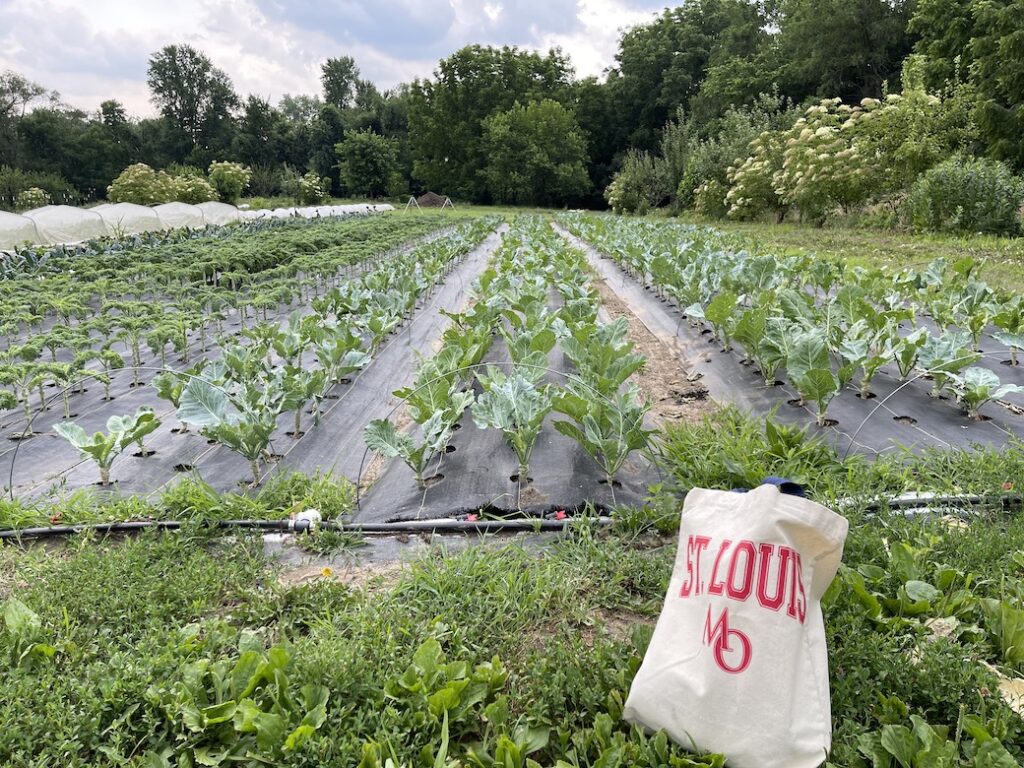
Jeanette McDermott, Vegan Storyteller
We really are limited only by our imaginations when advocating for a vegan lifestyle. Another way we can become horticultural activists is by purchasing food at farmers markets and buying produce shares through Community Supported Agriculture. We can also volunteer at city farms to help strengthen them.
City farms in urban areas usually involve people working with animals and plants in a community-run setting. Two of my favorite examples in St. Louis are
- Earth Dance Organic Teaching Farm, which models sustainable food production on a 14-acre historic farm in Ferguson, Missouri. Through its Organic Farm School programs, EarthDance cultivates food leaders alongside abundant fresh produce. From its origin on an acre of rented ground at the Mueller Farm in 2008, EarthDance has grown into a nationally recognized leader in farming education.
- In North St. Louis, New Roots Urban Farm stands against the dominant capitalist model of exploitation and oppression and grows and shares organic produce in order to exercise food sovereignty.
Organic activism
In the late 1960’s, concern about the environment, the treatment of animals, and the safety of the food we consume captured the attention of many Americans. Organic food cooperatives emerged as a result of this.
According to Craig Upright, author of the book Grocery Activism, “The goal so many worked toward…has been achieved; organic food has now achieved mainstream acceptance. Even so, cooperatives thrive…The social change many championed when this movement began more than 40 years ago — the hope that they could challenge the dominance of prevailing agricultural paradigms — has been realized without leading to the irrelevance of co-ops.”
Veganism is on the verge of reaching the same kind of success that the organic movement has reached. All levels of horticultural activism, including the personal and small act of filling a grocery cart, have power.
Cooking activism
Then, of course, there’s cooking activism. By cooking our own food, we are essentially boycotting restaurant chains and non vegan restaurants while getting healthier at the same time.
Preparing our own plant-based meals allows us to avoid stabilizers, preservatives, and added sugars while reducing our risk of heart disease, diabetes, cancer, and other diseases. Besides the health benefits, preparing our own food gives us greater control over the social and environmental impacts of our consumption. Preparing food at home is also cost-effective.
You probably realize now that what I said earlier is true: vegan activism is limited only by our imaginations.
Three Midwesterners use the Power of One to create change in their communities through vegan advocacy actions
Veganism is easy to champion. The only thing you need is the passion to affect change. Here are examples of three people in the Midwest who used the Power of One to put their passions into play to make a difference and grow the vegan movement in their communities.
Hillary Rettig started Vegan Kalamazoo in a city that had no organized vegan community. She grew the Michigan group from zero followers to 4,500 and expanded the range of vegan options available in Kalamazoo and surrounding towns. She also contributed to the growth of several other local ones. She built a thriving Facebook group that has a well-established culture of kind and respectful behavior. Read more
Kyle Luzynski founded Project Animal Freedom (PAF) with a bold mission of building a fully vegan Midwest by 2056. He set out immediately to find like-minded people to grow the St. Louis-based organization to fight for animal rights and grow the animal rights and vegan movements. People responded to his mission with such enthusiasm that staff and volunteers are currently working to open two more chapters in Missouri by the end of 2021. Read more
Ivory Levert received a grant from VegFund to create a safe space for the vegan Black community in Columbus, Ohio. The space, called Plant the Power 614, cultivates a caring plant-based community for people of African descent that demonstrates unconditional love for themselves, other animals, and the world. Read more
Maximizing the impact of vegan advocacy
It is not a question of whether to become a vegan activist; you already are one by the nature of your vegan lifestyle.
The question then becomes how you can maximize the impact of your advocacy work as a vegan. This blog offers many suggestions for ways to engage in vegan activism and animal right. But ultimately, you are the only one who can decide what position you want to take and how you are going to devote your passion, personality, and energy to the cause.
Whatever course of action you decide to take, be careful along the way so you don’t burn out. You are no good to the cause if you go up in flames. Slow and steady wins the race. Be persistent, consistent, and diligent in your progress.
If your progress appears to you to be slow, step back and reevaluate your engagement to put things in perspective. Stay steady and stay the course. Be realistic in the demands you place upon yourself. Read stories of how others are helping to win the good fight.
You will produce results by taking steady and methodical steps consistently. Rushing to achieve goals could result in burnout and not finishing the important task of making the world a better place for animals, people, and the planet.
Onward!

Ray Ippolito speaking at the Project Animal Freedom Climate Summit on Earth Day 2021, credit Project Animal Freedom
Foundations, investment clubs, and other giving organizations are eager to hear how they can help vegans conduct street actions, community outreach and educational programs, as well as other forms of vegan advocacy and enterprise.

Read where to find grants for vegan advocacy actions

